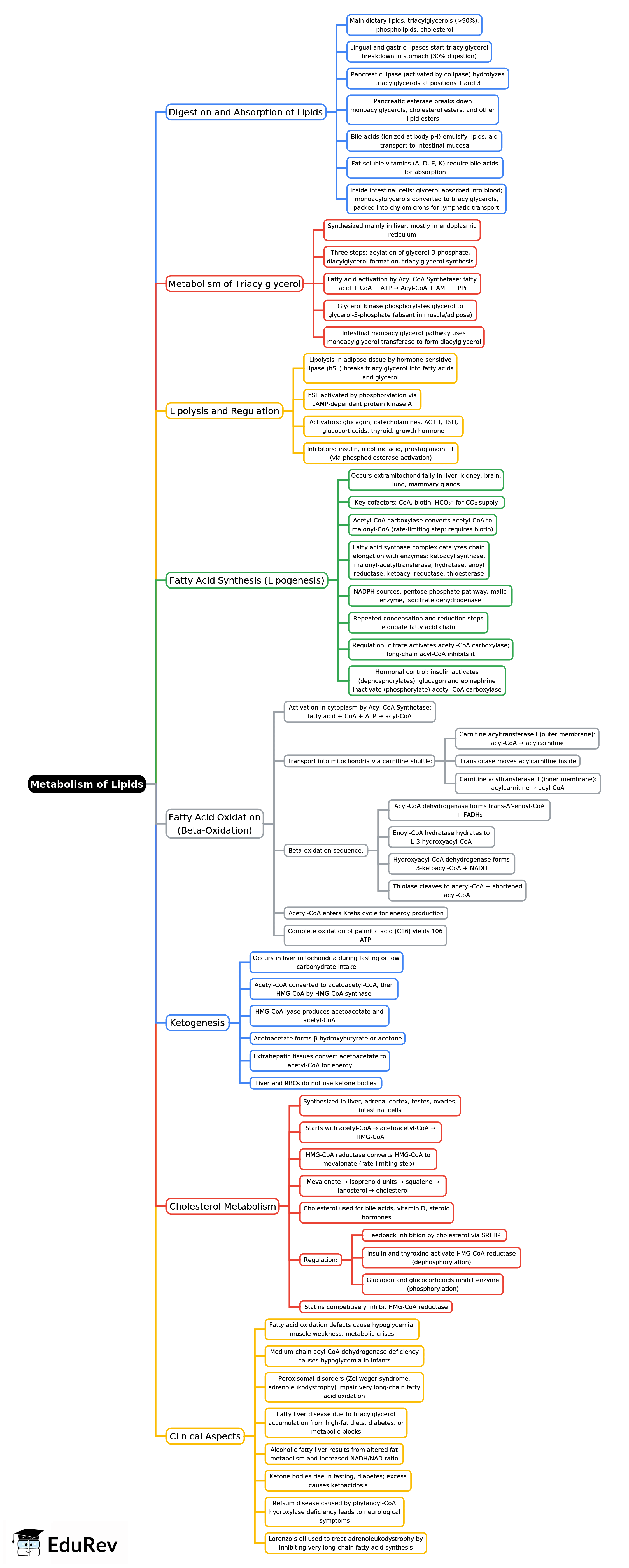NEET PG Exam > NEET PG Notes > Biochemistry > Mind Map: Metabolism of Lipids -1
Mind Map: Metabolism of Lipids -1 | Biochemistry - NEET PG PDF Download

The document Mind Map: Metabolism of Lipids -1 | Biochemistry - NEET PG is a part of the NEET PG Course Biochemistry.
All you need of NEET PG at this link: NEET PG
|
48 docs|7 tests
|
FAQs on Mind Map: Metabolism of Lipids -1 - Biochemistry - NEET PG
| 1. What are the main pathways involved in lipid metabolism? |  |
Ans. The major pathways of lipid metabolism include lipolysis, β-oxidation, lipogenesis, and ketogenesis. Lipolysis is the breakdown of triglycerides into glycerol and free fatty acids. β-oxidation occurs in the mitochondria, where fatty acids are oxidized to produce acetyl-CoA, which can enter the citric acid cycle for energy production. Lipogenesis is the synthesis of fatty acids from acetyl-CoA, primarily in the liver and adipose tissue. Ketogenesis is the formation of ketone bodies from excess acetyl-CoA, particularly during fasting or low-carbohydrate diets.
| 2. How does the body transport lipids in the bloodstream? |  |
Ans. Lipids are transported in the bloodstream primarily through lipoproteins, which are complexes of lipids and proteins. The main types of lipoproteins include chylomicrons, very-low-density lipoproteins (VLDL), low-density lipoproteins (LDL), and high-density lipoproteins (HDL). Chylomicrons transport dietary lipids from the intestines to other tissues. VLDL carries triglycerides from the liver to peripheral tissues. LDL, often referred to as "bad cholesterol," delivers cholesterol to cells, while HDL, known as "good cholesterol," helps transport excess cholesterol back to the liver for excretion.
| 3. What role do enzymes play in lipid metabolism? |  |
Ans. Enzymes are crucial for the various reactions in lipid metabolism. Key enzymes include lipases, which catalyze the hydrolysis of triglycerides into fatty acids and glycerol. Acyl-CoA synthetase activates fatty acids for β-oxidation by converting them into acyl-CoA. Carnitine acyltransferase facilitates the transport of fatty acids into the mitochondria. Additionally, fatty acid synthase is involved in lipogenesis, catalyzing the synthesis of fatty acids from acetyl-CoA. Each of these enzymes is regulated to ensure that lipid metabolism meets the energy needs of the body.
| 4. What is the significance of ketone bodies in lipid metabolism? |  |
Ans. Ketone bodies, including acetoacetate, β-hydroxybutyrate, and acetone, are significant byproducts of fatty acid oxidation during periods of prolonged fasting, carbohydrate restriction, or uncontrolled diabetes. They serve as an alternative energy source for tissues, particularly the brain, when glucose availability is low. Ketogenesis occurs primarily in the liver and helps to spare glucose for cells that require it, thus playing a vital role in maintaining energy homeostasis in the body during states of low carbohydrate intake.
| 5. How are lipids involved in cellular signaling? |  |
Ans. Lipids play a vital role in cellular signaling through various mechanisms. Phospholipids, such as phosphatidylinositol, can be phosphorylated to produce inositol trisphosphate (IP₃) and diacylglycerol (DAG), which are important second messengers in signaling pathways. Additionally, certain fatty acids, like arachidonic acid, can be converted into eicosanoids, which are signaling molecules involved in inflammation and other physiological responses. The ability of lipids to form lipid rafts in cell membranes also facilitates signal transduction by clustering receptors and signaling proteins together, enhancing their interactions and efficiency.
Related Searches















